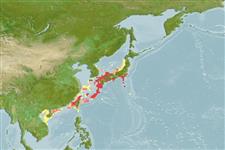Common names from other countries
分類 / Names
共通名の | 類義語 | Catalog of Fishes(部類, 種) | ITIS | CoL | WoRMS | Cloffa
>
Gobiiformes (Gobies) >
Gobiidae (Gobies) > Gobiinae
Etymology: Eviota: No etymology given, suggested by Christopher Scharpt: from Latin 'eu' for 'true' and 'iota' for anything very small, in combination 'truly very small' referring to it as being the smallest vertebrate at the time it has benn described by Jenkins (thus, making the suggestion by Scharpt plausible.; masudai: Named after Hajime Masuda (Ref. 76829).
Environment: milieu / climate zone / depth range / distribution range
生態学
海 関連する礁; 深さの範囲 2 - 64 m (Ref. 76829). Temperate
Northwest Pacific: Japan, also Ogasawara and Ryukyu Islands.
サイズ / 重さ / 年齢
Maturity: Lm ? range ? - ? cm
Max length : 3.2 cm SL オス/雌雄の選別がない; (Ref. 76829); 2.7 cm SL (female)
簡単な記述
検索表 | 形態学 | 形態計測学
背面の脊椎 (合計) : 6 - 7; 背鰭 (合計) : 9 - 10; 肛門の骨: 1; 臀鰭: 9. This species is distinguished by the following characters: D VI-I, 10 (9 in only one paratype); typical males (11 of 14 males) have elongate and filamentous dorsal spines reaching to anterior 4th to 8th soft rays of second dorsal fin; A I, 13; pectoral rays 17-18; including 13-17 branched rays; pelvic rays I, 4, I (fifth ray absent in 2 paratypes), fifth pelvic ray greatly reduced, averaging 14.1% (7.0%-28.0%) of fourth ray length, well developed pelvic-fin membranes extending beyond base of first branch of each pelvic-fin ray; lateral scale rows 23-25; transverse scale rows 6-8; cephalic sensory pore system complete sensu Lachner & Karnella (1980); genital papillae of males non-fimbriate; body light pink; edge of scale pockets reddish brown or brown; forming network on body; a small round bluish black or dark brown blotch on each side of nape just above opercle; 2 short longitudinal reddish brown or brown lines on cheek; the upper running posteriorly from postero-ventral corner of eye to a point midway between eye and posterior end of opercle, the lower line running from corner of mouth to a vertical line through posterior edge of eye; a short longitudinal reddish or dark brown line on anteroventral part of preopercle, just below the lower line on cheek; 2 short longitudinal reddish brown or brown bars or oval blotches on pectoral-fin base; one each on the dorsal and ventral part (Ref. 76829).
Occurs in shallow rocky reefs (Ref. 76829).
Life cycle and mating behavior
Maturities | 繁殖 | Spawnings | Egg(s) | Fecundities | 幼生
Matsuura, K. and H. Senou, 2006. Eviota masudai, a new gobiid fish (Teleostei: Perciformes) from Japan. Mem. Natl. Sci. Mus. (41):341-349. (Ref. 76829)
CITES (Ref. 128078)
Not Evaluated
Human uses
用具
特記事項
XMLをダウンロードして下さい
インターネットの情報源
Estimates based on models
Preferred temperature (Ref.
115969): 17.4 - 25.2, mean 21.3 (based on 52 cells).
Phylogenetic diversity index (Ref.
82804): PD
50 = 0.5000 [Uniqueness, from 0.5 = low to 2.0 = high].
Bayesian length-weight: a=0.01023 (0.00477 - 0.02194), b=3.02 (2.84 - 3.20), in cm Total Length, based on LWR estimates for this (Sub)family-body shape (Ref.
93245).
栄養段階 (Ref.
69278): 3.1 ±0.3 se; based on size and trophs of closest relatives
回復力 (Ref.
120179): 高い, 15か月以下の倍増期間の最小個体群 (Preliminary K or Fecundity.).
Fishing Vulnerability (Ref.
59153): Low vulnerability (10 of 100).
